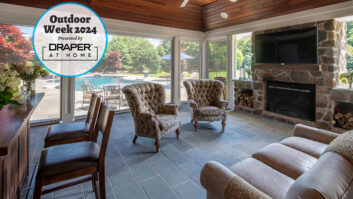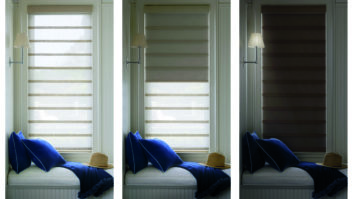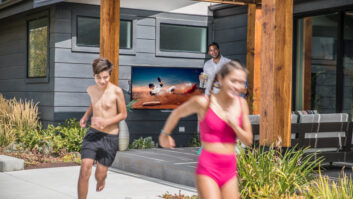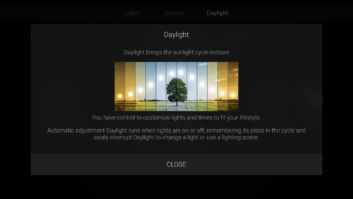Kudos: Smart design, greatly upgraded video, Android TV streaming
Concerns: Pricey, lackluster warranty, audio still needs improvement
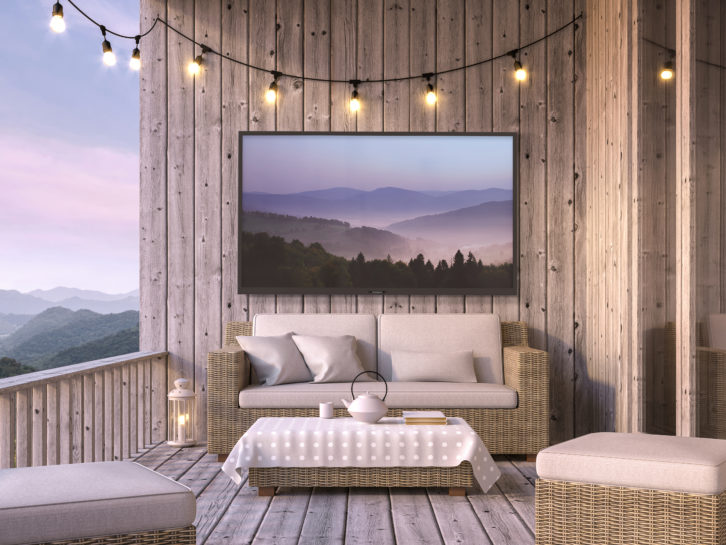
With the increase of summer kitchens, screened-in porches, pool houses, and other elaborate outdoor living and entertaining spaces, customers are no longer content with just having some audio outside; increasingly they expect to have video options available as well. I mean, if you can’t relax in a lounger by the pool with a beer while still watching your favorite sports team, can you even really say you’re living?
When customers bring up an outdoor television, there are really two options: purchase a cheap, regular TV and understand it will die sooner than later and need to be replaced, or purchase a weatherproof TV designed to withstand the elements.
But even when not exposed directly to the elements like rainfall, many environments just aren’t “friendly” for traditional indoor TVs. In Myrtle Beach where I live, the air is wet almost all year round. We’re cold and wet in the winter and hot and wet in the summer. Customers close to the ocean have salt in the air to deal with as well. Our temps can dip into the teens in the winter and well over 100 in the summer, plus, there is a lot of pollen during parts of the year — all of which can wreak havoc with the sensitive chips, circuits, and connectors in modern displays. Our typical response to customers wanting to install an indoor TV outside is that the warranty is void the second we hang it.
When it comes to true outdoor TVs, there are an increasing number of options available, including The Terrace from Samsung, Neptune from Peerless, SkyVue, and Seúra. Of course, one of the biggest names in this category is SunBrite TV, which launched the world’s first true outdoor TV back in 2004. The company increased its dealer reach when it was acquired by SnapAV (now Snap One) back in 2015.
SunBrite offers three different models in its outdoor range, which it describes as “full-shade” (Veranda), “partial sun” (Signature 2), and “full sun” (Pro 2). While the weather resistance — IP55 — remains the same on all the series, the more expensive sets have different screen coatings and are designed to withstand more heat and higher operating temps from direct sunlight. And this is “turn a hose on it and spray it down” weather resistance.
While the previous generation Veranda sets were designed to withstand the elements, there was definitely room for improvement. For one, at 350 nits it struggled when competing with ambient lighting, and there was no network connectivity for streaming. When SunBrite announced a Gen 3 refresh to the Veranda line, it appeared to check nearly all the boxes of what an outdoor TV needed to deliver.
Gen2 to Gen3
You expect a next-generation product to have numerous improvements, and the Gen3 panel definitely has multiple performance, feature, and design upgrades that make it a significantly more compelling solution. First, at 1000 nits peak brightness, it is nearly three times as bright as the previous gen, which is probably one of the most important features of an outdoor television. Picture quality is also improved with Quantum Dots technology for more vibrant colors, the inclusion of 72 local dimming zones for superior contrast, and support for Dolby Vision.
The Gen3 series also run Android TV with built-in dual-band Wi-Fi, letting it download numerous streaming apps, including all the big ones you’d expect. On the audio front, it supports Bluetooth broadcasting to a wireless speaker or headphones, now offers eARC for connection to a soundbar or audio system, and supports Dolby Atmos and IMAX Enhanced audio. It also supports IP integration with third-party control systems, namely Control4.
Other than performance upgrades and feature improvements, there are a few other big changes in the Veranda Gen2 to Gen3 series that are notable.
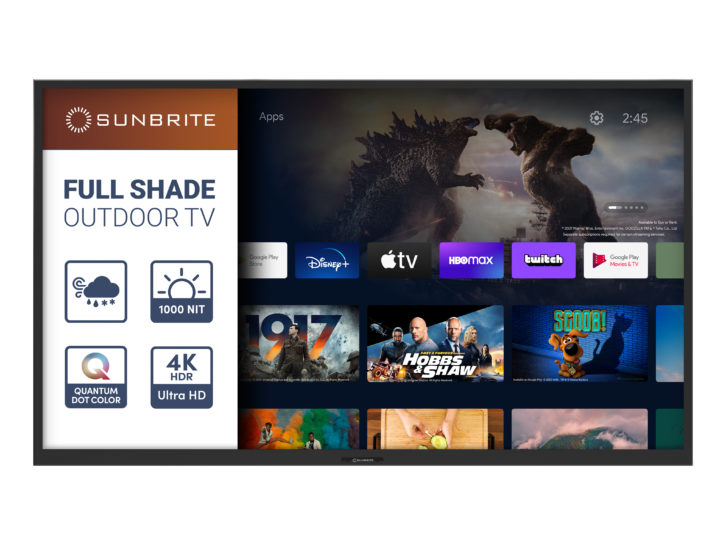
For one, gone is the 43-inch size; the 55-inch set is now the smallest offering. (The Gen3 series retains 65- and 75-inch models.) For customers not wanting a larger screen — the 55-inch model is nearly 50-inches wide — they will need to stick with the 43-inch Gen2 model, which is still being offered.
For another, SunBrite no longer offers a tabletop stand option. Admittedly, nearly every outdoor TV we’ve installed has been wall- or ceiling-mounted — with SunBrite offering a variety of weatherized options — but we have installed a couple where the TV just sat on a countertop.
Finally, there has been a significant price increase in the Gen3 sets. While the Gen2 always carried a price premium over an indoor set, the 55-inch set wasn’t too much a stretch for a true outdoor TV at $1999 (now reduced to $1769). However, the new 55-inch Gen3 model carries an MSRP of $2899, which might be a gut-check for some buyers, especially considering a “cheap” 55-inch 4K smart TV can be found for around $300. The new 65-inch set retails for $3649 and the 75-inch will be $4999.
One thing that hasn’t changed is the lackluster one-year warranty offered by SunBrite. If you are asking for customers to invest in a TV that carries this kind of pricing premium, it should include a better warranty, preferably three years. SunBrite, if you want us and our customers to bet on you, you could put a little skin in the game as well. Just sayin’.
Setup
You can tell this is no regular TV right from the get-go, and this is probably one of the best packed sets I’ve ever received. Between the extra-thick cardboard box, to the heavy foam cushioning at all corners, to the thick, full-panel cardboard screen protector, the chances of receiving a damaged panel — short of a head-on forklift blade strike — are pretty remote.
The longer I am in this business, the one thing I really appreciate is smart, well-thought-out design touches, and there were multiple things that stood out to me. First, the powder-coated aluminum rear panel has been redesigned so it is flat all across, removing the large bump-out of the media bay from the previous model. They also repositioned and reoriented the rear-panel power cord so it doesn’t impact wall-mounting. Also, they made sure that the wall-mounting holes don’t impact access to the weather-protected input compartment. Finally, the battery compartment on the IP56-rated remote is also screw-down and weatherized, helping it to survive inclement weather. It’s just clear a lot of thought went into the ways to make this Gen 3 model better.
Since the 55-inch SB-V3-55-4KHDR I was sent for review wouldn’t be a permanent addition at my home, that ruled out wall-mounting, so I went online and purchased a Perlesmith universal tabletop stand. While this fit the 400×400 VESA pattern on the TV, the base was definitely on the smaller size for the TV’s 47-pound weight, and I worried a bump might cause it to topple.
Initial setup is similar to any Android TV, where you connect to the network (wired or 2.4/5G Hz Wi-Fi), register the TV, then download and install any desired apps. You can easily move the apps around to your preferred order. The TV also supports Chromecasting.
If streaming isn’t your thing, there are numerous inputs for other sources, all protected behind a sealed, weather-protected hinged door held down by three thumb screws. This includes four HDMI and one mini-jack that accepts analog AV. Should outdoor gaming be your thing, two of the HDMI inputs are 4K/120 compatible, and the TV has AMD’s FreeSync Variable Refresh Rate to eliminate screen tearing, stuttering, and judder by syncing the TV’s refresh rate with the frame rate of the gaming console. Oh, and while in Game mode, the panel has a rated 8ms response time.
On the audio front, the TV has connections for eARC (HDMI 3), Toslink, and a mini-jack analog output, as well as a special connection for a SunBrite passive soundbar.
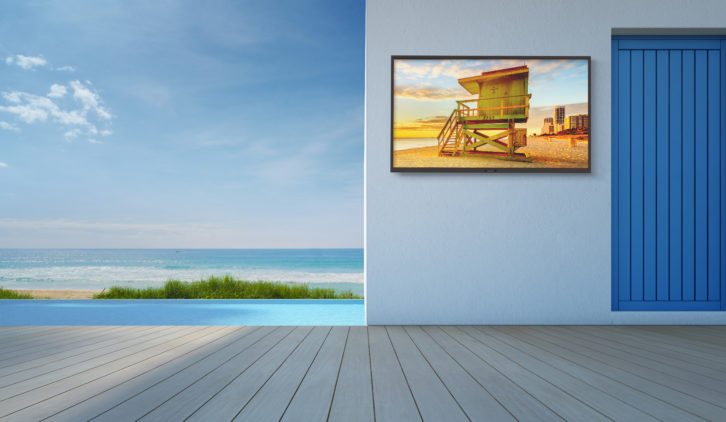
Another really smart addition is that the remote pairs to the TV via Bluetooth for no-point operation. The remote also features direct access buttons for Netflix, Prime Video, YouTube, Disney+, tubi, and Peacock. It has a “FAV” button that can be programmed to go to a specific input or another app or a “Device Assistant” page that gives some useful functions like a WLAN channel scanner and signal strength meter that lets you check the Wi-Fi conditions the TV is seeing. The remote also has a Google Assistant voice button that can be used for search or other requests.
Speaking of the remote; don’t lose it. The TV features only a single button with very limited functionality, letting you toggle through choices that include input cycling, TV power, and a remote finder. While I love the idea of the remote finder, the beeping of the remote is so quiet, I could barely hear it even when holding it.
Control
Another nice upgrade is the integration with third-party control systems. Beyond the mini-jack input for IR control in the rear panel — and a full suite of IR hex codes including discreet power on/off available — the set also now supports IP control.
As SunBrite is now owned by Snap One — which also owns Control4 — it’s no real surprise that Control4’s SDDP is supported, making it a simple drag-and-drop procedure to add the TV to your Control4 project. With the TV in your Control4 project, you can then add mini-app control for quick access to a number of popular streaming services.
While the Control4 integration worked terrifically once the TV was on, I did have issues getting it to turn the TV on to begin with. SunBrite says it issued a firmware update that was designed to improve the stability of the WakeOn LAN performance, but even after installing it, the set would only come out of standby via IP for me about 25 percent of the time. After a call with Snap One’s engineering team, I learned there are some settings that need to be made in the Advanced System menu for reliable IP control. Screenless Mode needs to be turned on, Serial/IP Control Port needs to be turned off, and Control4 Control Port needs to be on. After making these changes, the set seemed to respond more quickly and reliably turn on. (Snap/C4 recently released an updated driver (v61) with enhanced documentation that specifically calls out these steps for successful integration.)
Also, there were a couple of occasions where I woke up to find the TV on, so clearly something was waking it up. (To be fair, these turn-ons happened before I made the settings changes suggested by Snap One.)
One of the great use cases for automation integration would be to allow you to set the TV’s picture mode based on different times of day, say using Outdoor Daytime during the day and then automatically switching to Standard or Outdoor Night during the evening. But the driver doesn’t currently give access to any of these picture mode commands in the Device Specific Command bank in programming. However, this feels like something that could be added in a future update, which would certainly allow for a potentially better user experience.
Ultimately, because I was only using the TV as a standalone streamer — the likely use-case for most customers — I found myself gravitating to using the included remote, especially with the Google Assistant voice option.
Audio Quality
While sound quality is rarely a consideration with an indoor TV, it is certainly a factor to consider with outdoor TVs, especially when you consider they are generally playing to a much larger area and competing with significantly more ambient noise. With an outdoor TV, the importance is often a case of needing quantity over quality.
Even with a much larger bezel than typical indoor sets, the SunBrite’s two down-firing speakers are located behind the screen. While the basic configuration of the two speakers powered by a total of 20 watts remains the same as the previous Gen, SunBrite says the speaker components received upgraded materials and the speaker enclosure has been updated to better funnel sound out of the TV.

Does it sound better? Maybe a little. The biggest drawback is that it just doesn’t play that loud. With the volume pegged at 100, I wasn’t able to hit 70 dB SPL at my seating position about 8 feet away while watching Netflix. It was loud enough to sit there and hear what was happening, but not loud enough that it would entertain a crowd of watchers. I think the sound would benefit from the reinforcement of being wall-mounted, which mine wasn’t. There are a couple of audio settings and a 5-band EQ that you can use to try and tweak dialog clarity if needed, but the only way to really increase the levels will be by adding a soundbar or other audio system.
The TV does include Dolby Atmos audio processing (which is “on” by default), and the audio definitely “raises” in height, sounds a bit fuller, and has a touch more clarity when it is engaged, but it doesn’t deliver any kind of immersive audio experience.
Interestingly there is a WiSA speaker option in the audio settings menu that is grayed out. When I inquired about this, this is the response I received: “SunBrite does not participate with WiSA, so the grayed-out button is a result of the standard being disabled. Customers can still stream audio via Bluetooth. We were unable to remove the button as it is a part of the base Android TV operating system.”
Picture Quality
From the moment I powered the set on, it was clear the picture was far brighter and sharper, with punchier, more vibrant colors than the previous Gen. Without question, this is a noticeable, huge step up in picture quality.
Another noticeable difference between the old and new models was the reflectivity of the screen, with the new version having a more matte finish that is better at minimizing reflections.
As mentioned, I installed this set on a third-party tabletop stand on a table outside by my swimming pool. Originally, I positioned it against a flat wall that exposed it to a lot of direct sunlight, and there were times when viewing the screen was difficult with the sun shining on the screen. And while it never had any overheating issues, the screen did get noticeably hot. (Also, I received the TV after the high temps of summer were over.) Ultimately, I moved it into a corner where it was more out of the sun’s path and partially shaded by my roof line, and this made for much better viewing. To be fair, the Veranda series is intended for full shade, so when installed in an environment like under a porch or a patio it would be plenty bright.
Also Reviewed by John Sciacca: Trinnov Audio Altitude16 Surround Processor
I also appreciated that SunBrite included a variety of picture modes with names that make a lot of sense. For example, “Outdoor Day” favors high brightness, turning the backlight to 100, turning off local dimming, and putting it into cooler/brighter color temperature; whereas “Outdoor Night” drops the backlight, turns local dimming to high, and lowers the color temp to a more accurate setting. There are also three modes for DolbyVision: IQ, Dark, and Custom. DolbyVision IQ utilizes the TV’s built-in light sensor to help optimize the picture based on lighting conditions.
Black levels and contrast are almost irrelevant when talking about outdoor viewing, especially during the day, but the black levels are certainly blacker and the set offers more contrast than the previous Gen. At night when local dimming is engaged (low/medium/high settings), it does a nice job of keeping blooming down in areas that should be black.
While the picture quality is excellent head-on, there are some issues as you get off-axis. Those extremely off-center will notice some color shift, as well as blooming in the sides and corners, most noticeable at night.
I can’t imagine anyone going to the trouble of calibrating the set — which generally lowers the overall light output — but there are options for gamma adjustments and 2- or 20-point color calibration.
The set also has a variety of motion settings with vague names like “Smooth” and “Clear” that allow you to change the amount of judder and blur reduction. There is also a customization option that lets you fine-tune the setting to taste. Much of the content I streamed was 4K/60, so I never noticed any issues with motion handling. There is also a “Clearness” setting that reduces the backlight’s flicker rate from 960 Hz down to 120 Hz, inserting more black frames into the image. This is used to reduce blur of fast-moving objects on screen, but it puts a massive hit on the brightness and doesn’t seem very usable in an outdoor setting.
SunBrite claims this set is “up to 4x brighter than many indoor TVs,” which seems dubious as nearly every modern LED TV capable of HDR delivers 1000 nits (or more). But I brought it inside and sat it next to a Sony XBR65X950H for comparison. While the Sony certainly bested it, with noticeably better black levels, better local dimming control, superior brightness, motion handling, and far-better off-axis performance, it proved how good the SunBrite was, with picture quality that was well beyond just “good enough.” Sure, a flagship Sony LED looks better, but put the Sony outside for a week/month/year and then test it again.
The Veranda TV lived outside nearly the entire time I had it, and during that time it was rained on multiple times. And I mean rained on. It still happily fires up each time I hit the power button. That is what you are getting with a SunBrite outdoor TV. I have a Gen2 Veranda TV, which is still working even after living outside, totally unprotected, for the past six years, which certainly speaks volumes about the set’s durability. Though it carries a premium price tag, the new Veranda Gen3 is a step up in every regard and makes a compelling solution for outdoor video.
866-357-8688; SUNBRITETV.COM
Product Specs:
- 4K HDR LED TV with Quantum Dot Color
- 1000-nit brightness, 6000:1 Contrast
- 72 local dimming zones
- Dolby Vision, Dolby Atmos, and IMAX Enhanced
- IP55 rated with -24–104-degree operating temperature
- Two down-firing speakers powered by a 20-watt amplifier
- Built-in dual-band 2.4/5 GHz Wi-Fi and Bluetooth
- Inputs: 4 HDMI inputs (two HDMI 2.1 inputs supporting 4K/120; HDMI 3 supports eARC), two USB (one service only), mini-jack composite audio/video (adapter required), mini-jack IR, mini-jack RS-232, RJ45 LAN, RF Connector (NTSC/ATSC/QAM); Outputs: mini-jack analog audio, Toslink digital, mini-jack connector for SunBrite soundbar
Dimensions: 49.75 x 29.25 x 4.25-inches (WxHxD); 47 pounds

